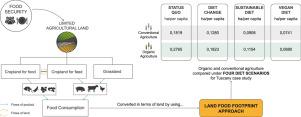Ecological Modelling ( IF 2.6 ) Pub Date : 2021-08-24 , DOI: 10.1016/j.ecolmodel.2021.109702 G.V. Lombardi 1 , Silvia Parrini 2 , R. Atzori 3 , G. Stefani 1 , D. Romano 1 , M. Gastaldi 4 , G. Liu 5, 6

|
Urban population growth has raised concerns about food security. Agricultural systems are asked to satisfy a growing demand of food while addressing sustainability issues and facing resources constraints. Ecological footprints are widespread instruments for the study of human impact and dependence on natural resources. Amongst these tools, Land Food Footprint (LFF) is used to measure the land actually used to produce the food needed to satisfy the demand of a given region or country. Understanding the differences between alternative production methods and the gaps between available and needed land is a crucial issue in order to integrate food security and sustainability issues into the food system. The objective of this study is to analyse the Land Food Footprint of Tuscany (Italy) for both organic and conventional agriculture, taking into account the nexus of diet. In this aim, Land Food Footprint for the considered production processes is assessed under four different diet scenarios with different levels of animal protein consumption. The study suggests that the gap between land needed by organic and conventional agriculture varies considerably between vegetable and animal products. It confirms that organic agriculture needs more land than conventional one but the gap between land footprints shrinks because of dietary changes. In this study, the most important finding is that organic agriculture might feed the case study population if the diet shifts towards a reduced intake of animal protein. In fact, with a diet reduction of 50% in animal proteins, the organic land food footprint value is equal to the conventional land food footprint under the status quo diet scenario indicating that organic agriculture would be able to address food security issues if food consumption was properly adapted to agriculture carrying capacity.
中文翻译:

可持续农业、粮食安全和饮食多样性。意大利托斯卡纳的案例研究。
城市人口增长引发了人们对粮食安全的担忧。农业系统需要满足不断增长的粮食需求,同时解决可持续性问题并面临资源限制。生态足迹是研究人类对自然资源的影响和依赖的广泛工具。在这些工具中,土地食物足迹 (LFF) 用于衡量实际用于生产满足特定地区或国家需求所需食物的土地。了解替代生产方法之间的差异以及可用土地和所需土地之间的差距是将粮食安全和可持续性问题纳入粮食系统的关键问题。本研究的目的是分析托斯卡纳(意大利)有机农业和传统农业的土地食物足迹,考虑到饮食的关系。为此,在四种不同的饮食情景下,对所考虑的生产过程的土地食物足迹进行了评估,这些情景具有不同的动物蛋白消耗水平。该研究表明,有机农业和常规农业所需的土地之间的差距在蔬菜和动物产品之间差异很大。它证实有机农业比传统农业需要更多的土地,但由于饮食变化,土地足迹之间的差距缩小了。在这项研究中,最重要的发现是,如果饮食转向减少动物蛋白的摄入量,有机农业可能会养活案例研究人群。事实上,在饮食中减少 50% 的动物蛋白,











































 京公网安备 11010802027423号
京公网安备 11010802027423号